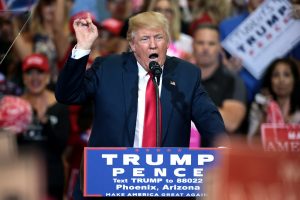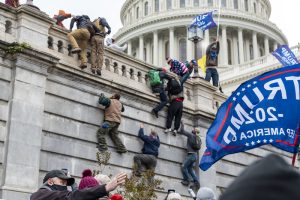By: Noah Smith, RightsViews Staff Writer
January 6, 2021, will live in infamy as the day American citizens defiled the United States Capitol. A day in which violent insurrectionists brandished the Confederate flag in the Capitol’s hallowed halls, sacked the empty Senate chamber, attacked and killed Capitol Police officers, and called for former Vice President Mike Pence’s execution. All in a miscarried attempt to forcibly overturn the results of the 2020 United States presidential election. Five people died and more than 140 were injured.
The atrocities of January 6, 2021, will leave an indelible scar on the conscience of our nation, reminding us all that democracy is fragile and human rights even more so.
In the aftermath of the Capitol attack, prominent conservative voices largely downplayed its severity. Matt Gaetz (R-Fla.) expressed his anger at the perpetrators just hours after the attack, stating

“some of the people who breached the Capitol today were not Trump supporters. They were masquerading as Trump supporters and in fact, were members of the violent terrorist group Antifa.” Rep. Paul A. Gosar (R-Ariz.) took to Twitter asserting that “This has all the hallmarks of Antifa provocation,” he wrote, about three hours after the Capitol attack. Trump and his allies sought to blame “Antifa,” — an ideology, not an organized group, according to the FBI —for the violence associated with the insurrection.
Furthermore, there is an active attempt by conservative media to downplay the actions of the insurrectionists. The late talk radio host, Rush Limbaugh, dismissed demonstrators at the Capitol as mere individuals who “breached the doors and took some selfies,” which he depicted as far less violent than civil rights demonstrations last summer. U.S. Sen. Marco Rubio compared the attack on the Capitol by a pro-Trump mob with Black Lives Matter protests in a video message after the Capitol attack, asserting that the unprecedented assault was comparable to what the left had been “justifying” this past summer in cities across America.“The events that we saw this week should sicken every single one of us … Riots should be rejected by everyone, every single time,” Rubio said. “Now, are the left hypocrites? Absolutely. I remember what they now are calling ‘insurrection,’ they were justifying just this summer.” This false equivocation of BLM and right-wing terrorism is not simply fallacious but dangerous, because it puts those who take up political & racial activism, in any form, at risk for charges of extremism.
The Capitol riot and the ensuing media coverage are emblematic of our new polarized reality, a reality in which right-wing authoritarianism, populism, and radicalization have shifted into the mainstream. Between 2014 and 2019, far-right terrorist attacks increased by 320 percent, and in 2018 right-wing terrorist attacks accounted for 17.3 percent of all terrorists’ incidents in the West. Indeed, the storming of the United States Capitol was in part precipitated by a rejection of human rights in which domestic terrorists would rather burn their country down than accept the human rights of others.
 In order to understand the proliferation of right-wing ideologies and the motivation of the insurrectionists, we must turn to psychology. Arie Kruglanski, a distinguished professor in the department of psychology at the University of Maryland and expert on extremism, asserted in an interview with the Los Angeles Times that “for the core participants and members of the far-right, the Capitol riot has been a great success. This has been a milestone in their fight against these windmills, these alleged enemies of America.” In his research examining thousands of violent extremists around the world — Neo Nazis in Germany, Tamil Tigers in Sri Lanka, and ISIS in Iraq— Dr. Kruglanski has articulated three mutually reinforcing pillars of radicalization: the three N’s of violent extremism.
In order to understand the proliferation of right-wing ideologies and the motivation of the insurrectionists, we must turn to psychology. Arie Kruglanski, a distinguished professor in the department of psychology at the University of Maryland and expert on extremism, asserted in an interview with the Los Angeles Times that “for the core participants and members of the far-right, the Capitol riot has been a great success. This has been a milestone in their fight against these windmills, these alleged enemies of America.” In his research examining thousands of violent extremists around the world — Neo Nazis in Germany, Tamil Tigers in Sri Lanka, and ISIS in Iraq— Dr. Kruglanski has articulated three mutually reinforcing pillars of radicalization: the three N’s of violent extremism.
The first is “need,” the motivation to feel significant and respected. This universal quest for significance is heightened when one’s dignity is in question, cheated, or disenfranchised. This “need” for significance is also exponentiated when the chance arises to enhance our significance, an opportunity to do something remarkable, become a hero or a martyr (e.g., storm the Capitol). All humans possess the desire to feel significant, yet few individuals resort to violent extremism to achieve this feeling. However, it is due to the two other N’s: “network” and “narrative,” that individuals resort to extremism. Precisely, the “narrative” unites the “need” to a specific course of action and instructs what must be done in order to achieve significance. Furthermore, the “network” (i.e., individuals’ communities) validates and avows the narrative. The “network” also confers respect upon the individuals who do what the narrative requires of them, and in the process, they become heroes or martyrs for their cause.
Applying this model of radicalization to the Capitol insurrection, it is evident that many of the insurrectionists felt an acute need for significance, as seen by insurrectionists taking copious selfies as the riot transpired and others live streaming the assault, all of which boosted these individuals’ significance within far-right networks. For some of the insurrectionists, the quest for significance was prompted by economic hardships resulting from the pandemic and the ongoing COVID-19 restrictions. Yet for others, their need for significance stemmed from a place of insecurity and fear precipitated by the ongoing national conversation of systematic racism and belief that the Black Lives Matter anti-racist movement threatens their place, even existence, in society. White nationalists have long propagated the “great replacement” conspiracy theory (i.e., “white genocide”), which asserts that a multitude of factors, such as an increase of non-white immigration, multiculturalism, and falling birthrates among white Americans, will result in white populations losing their position as the dominant demographic. This conspiracy theory creates a volatile dynamic in which supporters view nonwhite people and immigrants as existential threats to their existence.
Far-right ideologies often amalgamate disparate grievances and fears into crusades that wrongly identify the culprits for their perceived grievances: LGBTQ Individuals, who they perceive are destroying the moral fabric of society, Jews, who they believe are controlling the “deep state” and responsible for the COVID-19 pandemic, as well as Black Americans and Liberals who they believe are taking over the country and stealing it from its rightful owners — “white Americans.”

Anti-Semitism, QAnon, and white supremacy are quintessential ideologies of the far-right movement, and their fear surrounding an event or group of persons is frequently out of proportion to the “real” threat posed by the “folk devils” (e.g., Black Lives Matter, LGBTQ people, Jews, Liberals, etc.). The term “folk devil” was coined by sociologist Stanley Cohen in 1972, and refers to a person or group of people who are portrayed as outcasts and deviants. Thus, for disparate far-right movements, in order to assuage the concerns of individuals who are obsessed with what this “folk devil” may do to warp society and pollute future generations, they must strip the “folk devil” of their citizenship, meaning full rights, entitlements, and opportunities that support security and well-being. Stripping individuals of their entitled rights threatens the very foundation of democracy because such actions decide who is worthy of rights rather than acknowledge the inherent rights, we are all entitled to. Politics has always been personal, especially for individuals with marginalized identities, thus the need to re-structure political discourse around enduring human rights principles is crucial.
What is clear in the aftermath of the Capitol attack, is that the siege was not a moment of reckoning in our country, as many of us hoped, but rather acted as a catalyst for the far-right movement. From the far right’s perspective, the Capitol attack was nothing short of heroic and referred to it as Republicans’ “1776 moment.” This rhetoric was validated by former President Trump’s video message he tweeted to the rioters: “So go home, we love you, you’re very special.” Furthermore, the fallout of the Capitol attack has deepened the split in the GOP between moderates and extremists, a split made starkly evident by Liz Cheney’s removal from House GOP leadership because she voted to impeach Donald Trump. Indeed, the institutions charged with protecting our rights are more divided than ever and have willfully shown their inability, or perhaps unwillingness, to protect certain individuals’ human rights if it is not politically advantageous.
Photos
“Donald Trump” by Gage Skidmore is licensed under CC BY-SA 2.0
“Capitol Jan 6” by Blink O’fanaye
“Capitol Jan 6” by Blink O’fanaye
